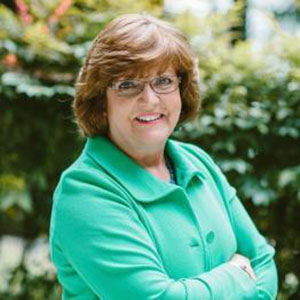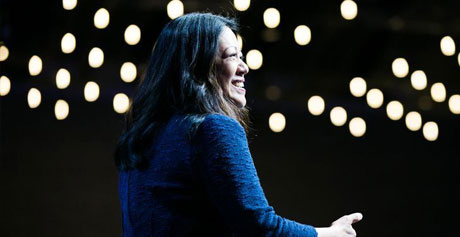An Exclusive Interview With Apex Learning’s Chief Academic Officer, Jean Sharp
 Q: Can you give us more insights about the work you are doing at Apex Learning and how this is impacting the digital learning space?
Q: Can you give us more insights about the work you are doing at Apex Learning and how this is impacting the digital learning space?
JS: As Chief Academic Officer, I am responsible for driving Apex Learning’s academic leadership in the market, with our customers, and for our solutions. I set the vision for curriculum and instructional design in Apex Learning’s digital learning solutions and align the needs of educators today with solutions that meet student learning needs and maximize student success. Prior to assuming the role as Chief Academic Officer, I served as Apex Learning’s Vice President, Content Development.
Q: Tells us more about your career accomplishments in the field of education.
JS: Prior to joining Apex Learning, I served as Vice President of Curriculum and Instruction for AdvancePath Academics, a public-private partnership working with public high schools across the country to improve graduation rates and reduce dropout rates in their local community. In that capacity, I had oversight of the curriculum and instructional model, fidelity of the implementation model based on research, and efficacy, effectiveness, and student success.
Previously, I served as Vice President of Curriculum Development at PLATO Learning Inc. I was responsible for the overall instructional design and development of computer based and e-learning courseware solutions for kindergarten through adult learners.
For several years I led Product Development at an educational startup. I was responsible for the planning, development, and management of all aspects of our online learning and training products for students, teachers, and parents in the K-12 market.
My entry into the software development and educational publishing market began with The Learning Company, formerly MECC (Minnesota Educational Computing Corporation), the company best known as the creators of The Oregon Trail. We were pioneers in educational software and produced numerous award-winning educational software products published for both school and consumer markets. In my tenure (ten years) with the company, we developed partnerships to bring award winning software programs to the education and consumer markets. I served as the Executive Producer for the American Girls Premiere, a partnership with Pleasant Company (now Mattel) to bring their highly acclaimed content to the computer screen. This product became the highest selling girl’s software product on the market. I also worked with well-known children’s authors to create interactive versions of their beloved books. I have fond memories of working with Tomie dePaolo to bring his picture book, The Art Lesson, to an interactive format.
And, of course, my time in the classroom and with students who inspired me to bring high-quality learning opportunities to students and classroom across the country through technology.
Q: What do you feel are some of the biggest challenges that the educational system is still facing when it comes to effectively educating our youth?
JS: Our students today are learning how to learn in an environment that is quite different than just a year ago. And it’s likely to impact how they will learn in the future. Amidst all of the change, we have to be fully engaged in the challenging work of moving education forward and finding ways to best serve the needs of students and their families.
Walt Disney once said, “Progress is impossible without change.” The pandemic has brought numerous issues to light and it is imperative that we find ways to address them. When we think about the role of education, there is much work to do to prepare our students for the future. Among the challenges (and by no means is this a comprehensive list) are:
- Equity of access: Last spring, schools did an amazing job of providing devices and hot spots to students to connect with their teachers and their lessons. Yet nearly 1 in 3 American households had limited computer or internet access. The data indicates that students of color, students from low-income households, and students whose parents earned a high school diploma or less are most likely to be on the wrong side of the digital divide, making it more difficult for them to access their classes, engage with peers, and complete their assignments. We must provide all students with access to technology and connectivity to support their learning
- Choice: As we’ve seen, all learning does not have to be face-to-face in order to be effective. Some students and families found virtual learning to be a very effective learning model. Well planned and implemented programs fulfill the promise to give students more control over the time, pace, path, and place of learning. It removes some of the distractions that negatively impact learning in the school building. If affords flexibility for work or family care needs. For those who have experienced success with virtual learning, districts will have to consider how to provide learning options that meets student and family needs or risk the reality that parents will choose to enroll their children in programs that excel in this model which will negatively impact enrollment and funding for public schools.
- Health and Well-Being of Students: We know all too well that in the past year, our students have experienced isolation, loneliness, anxiety, depression, and trauma. Interaction with peers and caring adults is so important for their growth and development, Schools must be intentional in their efforts to address the overall health and well-being. Schools must promote the long-term development and success of all children by ensuring that each student is healthy, safe, engaged, supported, and challenged.
- Addressing learning loss: Many fear that the lack of availability to consistent learning throughout the pandemic will expose learning gaps and deepen the achievement gap. We must meet students where they are by assessing students’ academic readiness toward grade level goals and tailoring instruction to meet their individual needs. This includes identifying and remediating learning gaps to bring students to grade level expectations.
- Future-ready: Research indicates that education is one of the least resilient industries. It is imperative, however, that we commit to preparing students for a world that is constantly changing. To be future ready, students will need strong resiliency skills to adjust and manage through change.
Q: Are there any challenges that you’ve faced as a female executive in the education field, if so how did you overcome these?
JS: I have served on the executive team for several private sector educational publishing companies over the years and have worked under the leadership of both male and female CEOs. Each organization I’ve served valued the knowledge, experience, expertise, and leadership I brought to my work. They afforded opportunities for me to take on new challenges and drive strategic initiatives. In turn, I was committed to a high level of excellence in my work and to making contributions that promoted the growth and success of the organization.
Q: After high school, where did you feel your career path would take you?
JS: Even in high school, I knew education would be my career path. It’s not too surprising, then, that my degrees are in education. Early in my career, I imagined a pathway of school or district level leadership. One day, my building principal opened the classroom door and left one computer on a rolling cart in the front of my classroom. Even in those early days of educational computing, the students in my classroom were eager to learn with technology. That changed everything for me, and I began to pursue a pathway in educational technology and instructional design.
Q: What would be the title of your autobiography?
JS: The first thing that comes to mind is Blessed. Make no mistake, life had had its challenges over the years and each challenge has brought a test of my resiliency. However, I feel fortunate to have the love and support of my family and to work in the field I love.
Q: What is one word of advice you can offer to young women who want to reach your level of success?
JS: Keep learning, build your resiliency, and continue to grow your leadership capacity. When opportunities come along, commit to making the most of them.
Q: Which woman inspires you and why?
JS: The woman who influenced and inspired me the most was my mother. She grew up in a small rural community in Illinois. Her mother died when she was seven years old, and her father raised five daughters. She was the first in her family to graduate from college and she held multiple degrees in education. She raised four children, was a teacher and education leader in our local community and instilled that love of learning in me from a very young age. Her imprint on my life is undeniable.
Q: How can people get in touch with you?
JS: Connect with me through LinkedIn. I enjoy meeting new people across the education, publishing, and software industry.
Five Things About Jean Sharp
1. What celebrity would you like to meet at Starbucks for a cup of coffee?
If truth be told, I don’t drink coffee. My drink of choice at Starbucks is a venti black unsweetened iced tea with extra ice, which I order nearly every morning. In fact, I have one on my desk now. If you scan my bookshelves, you will discover that I own nearly every leadership book John Maxwell has ever written. And over tea, I would like to talk with him about turning mistakes into steppingstones for success, a concept he detailed in his book Failing Forward. Years later, I still reach for this book often.
2. What would your perfect vacation look like?
My husband and I enjoy traveling. When we are overseas, we often pick a city that can serve as our hub. We then plan days in the city and day trips outside the city to explore the surrounding area. That affords us the perfect balance of busy days of exploration and touring contrasted with leisurely days visiting parks, museums, and great restaurants in the city. We also enjoy a “do nothing” vacation where we arrive at our destination with no real plans and simply make it up day by day.
3. Favorite city?
It’s hard to pick just one. But Chicago is near the top of my list. I was born and raised in the Chicagoland area, so it holds many memories from my childhood. To this day, I love the view of the city when you drive along the lakefront or walk along Michigan Avenue. There’s always something to do---exploring the museum campus, taking an architecture tour along the Chicago River, walking through Millennium Park, or taking the EL to the northside. We make it a tradition to return Chicago in the summer to cheer on our Chicago Cubs at Wrigley Field. Whenever we visit, we enjoy the uniquely Chicago cuisine---deep dish pizza at Unos or Giordano’s, or Gino’s East and Chicago hot dogs at Portillos.
4. What app can’t you live without?
My FitBit app. I am an avid walker and I monitor my steps every day. I love the challenge of meeting and surpassing my goals. And FitBit awards me with badges when I hit certain distance milestones. I don’t mind a moment to boast on an accomplishment!
5. What’s your favorite international food?
A few years ago, my husband and I traveled to Rome. I’ve always enjoyed Italian food, but on this trip, we decided to take a cooking class. A local chef met us at a restaurant near Trevi Fountain and guided us through the preparation of an amazing meal. On that same trip, we took a day tour to Tuscany where we had lunch at a generations owned family farm and winery. Each course had a story shared by one of the family members who prepared the meal. Magnificent!

